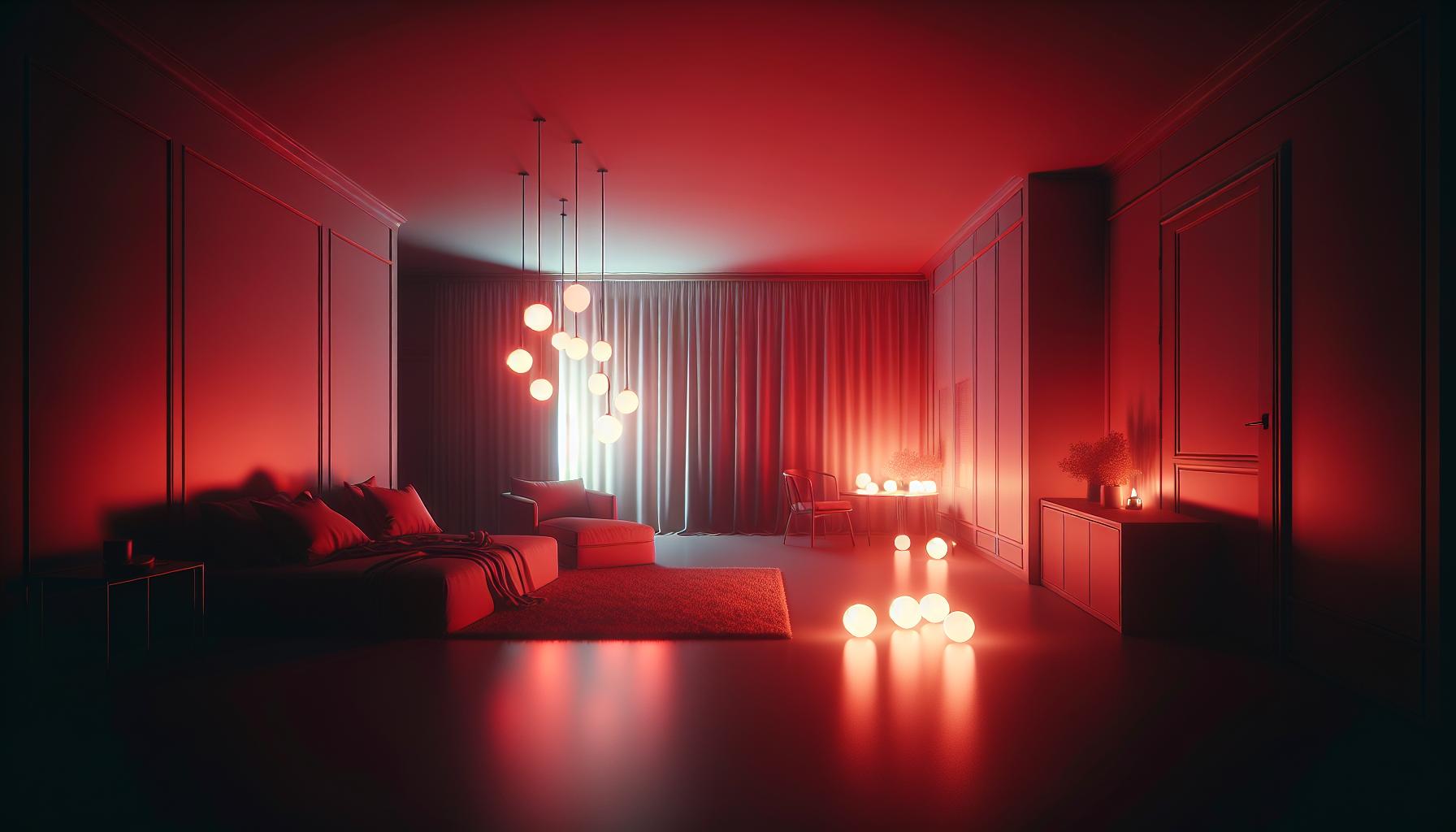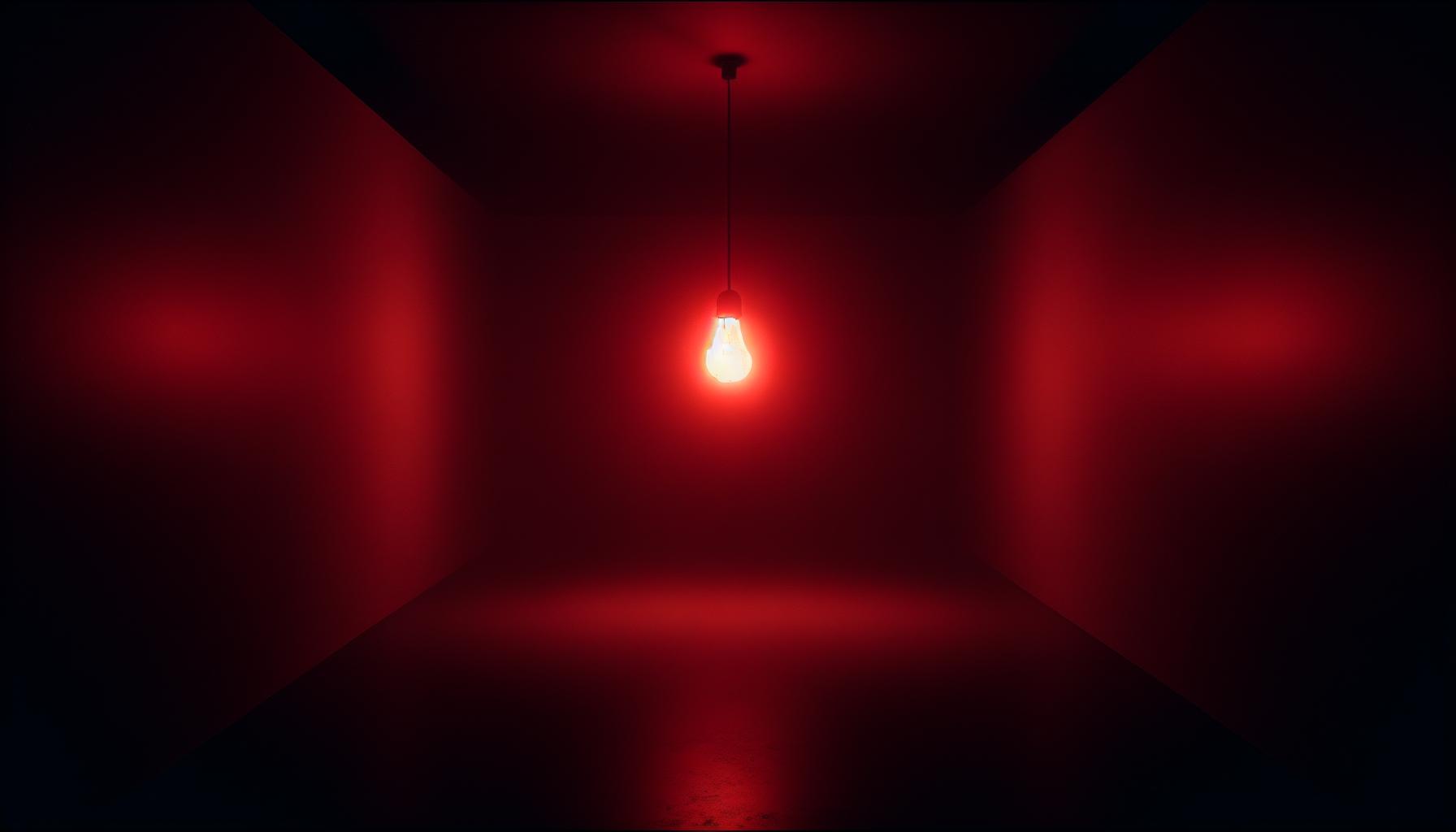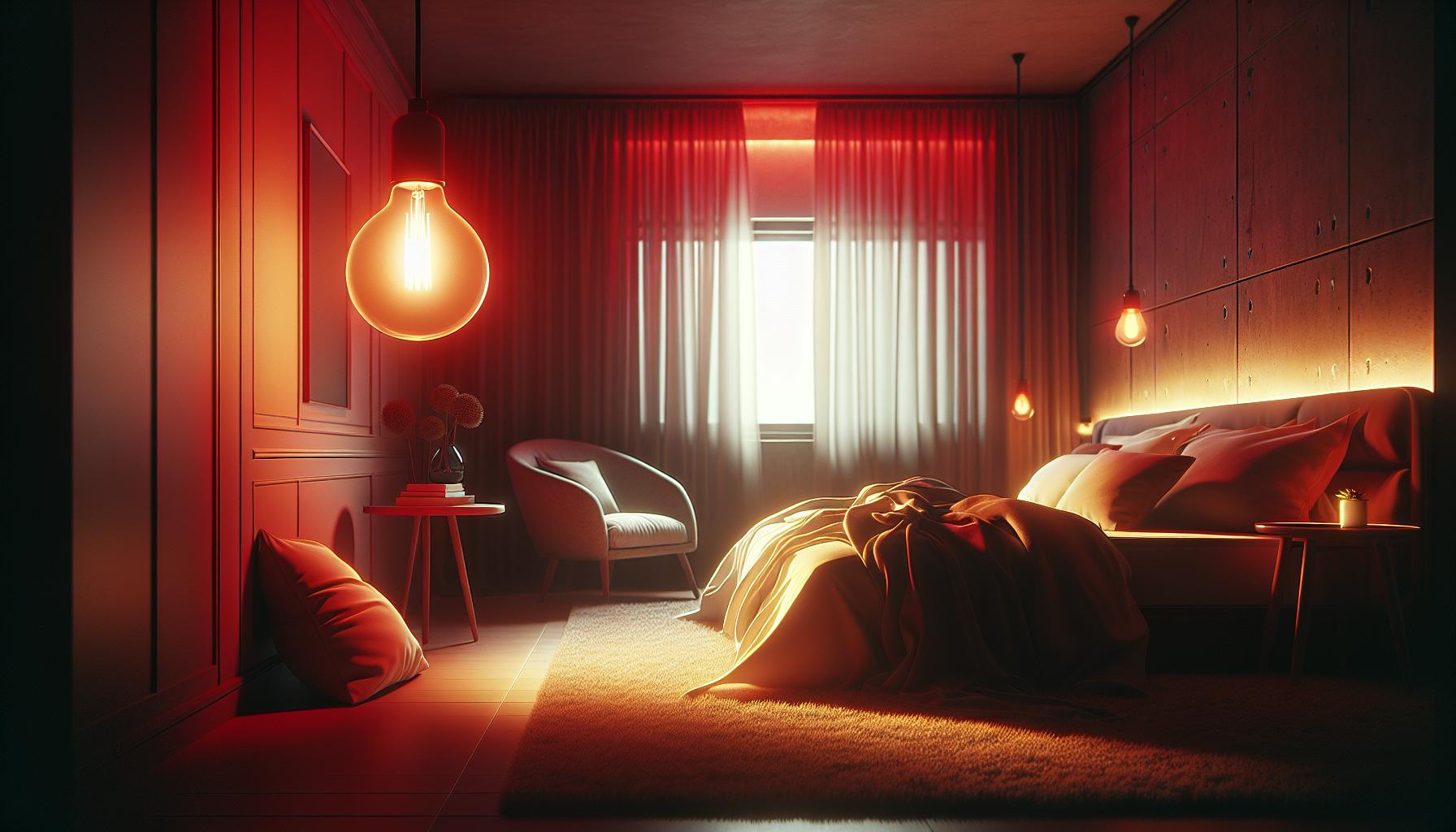Ever wondered why red light bulbs pop up in some of the most unexpected places? It’s not just for a spooky Halloween effect or to set a romantic mood. These crimson illuminators have some pretty unique uses that might surprise you.

From guiding your steps in the dark without ruining your night vision to playing a crucial role in photography darkrooms, red light bulbs are more versatile than you might think. Let’s dive into the world of red light and discover its practical applications that go beyond mere decoration.
What are Red Light Bulbs?
You’ve seen them around, and they catch your eye with their distinctive glow. Red light bulbs are special purpose bulbs primarily known for their deep red color. They are not your regular incandescent, CFL, or LED bulbs that are used for everyday lighting; these are designed to produce light at the red end of the visible light spectrum.
But what makes them so unique? Red light bulbs have a range of wavelengths from approximately 620 to 750 nanometers, sitting snugly at the edge where visible light meets infrared. This wavelength is what gives them the edge in various scenarios where preserving night vision or creating a specific atmosphere is essential.
Beyond the science, these bulbs have become incredibly popular for their versatility and functionality in multiple settings. If you’re into home DIY projects, these bulbs can be the perfect touch for creating ambient lighting or themed rooms. Artists and photographers find them indispensable in creating environments that don’t affect light-sensitive materials.
Yet, there’s more to them than meets the eye. Red light bulbs also serve well in situations requiring low-light conditions that won’t distract or bother others. For instance, when you’re tinkering in your garage on a late-night project, a red light bulb ensures you’ve got enough visibility without the harshness of bright white light.
Moreover, for all the gardeners out there, these bulbs can be a boon. Plants respond differently to various light spectrums, and red light, in particular, can influence the growth, flowering, and fruiting stages. It’s no wonder that some gardeners employ these bulbs to give their plants a little extra “oomph.”
In a nutshell, red light bulbs are a multifaceted tool in your lighting arsenal. Whether it’s guiding you through a late-night snack without waking the household or helping your photos develop to perfection, their uses might just surprise you.
The Science Behind Red Light

Imagine stepping into a room bathed in red, a world where only hues of warmth gracing every corner invite you in. As a lighting expert whose heart beats for the perfect glow, you know there’s more to red light bulbs than meets the eye. Red light isn’t just a color—it’s about wavelengths and perception, and how our eyes and bodies respond to this part of the spectrum.
Red light bulbs emit long wavelengths typically ranging from 620 to 750 nanometers. At this end of the spectrum, red light is less energetic compared to blue or white light, but it packs its unique set of advantages that you, a home DIY enthusiast, can harness in creative and practical ways.
Your eyes are less sensitive to red light, and it doesn’t disrupt your night vision as significantly as other wavelengths do. That’s why astronomers and wildlife observers turn to red light when they’re active in the dark. It gives you just enough visibility without compromising your ability to see in low-light conditions later on.
But there’s more to red light than preserving your night vision—it influences circadian rhythms, the internal processes that regulate your sleep-wake cycle. Bathing in red light at night can help maintain the melatonin production your body needs for a good night’s rest, unlike blue light, which can keep you tossing and turning.
In your home projects, using red light can transform a space not only by ambiance but by utility. Hone in on this unique light quality to create rooms that double as nighttime sanctuaries, promoting better sleep and relaxation.
When it comes to plants, red light works its magic by driving photosynthesis, playing a pivotal role in plant growth. The light spectrum is crucial for your indoor garden, and integrating red light bulbs can significantly boost the growth and flowering of your plants, a tip that could make your green thumb even greener.
« How Does a Light Bulb Security Camera Work? Unveiling Secret Tips for Your Safety
What Light Bulbs Are Most Energy Efficient? Shocking Truth Revealed »
Step back from your latest DIY lighting project and watch as the red light does more than illuminate—it sets the mood, protects your night vision, and even supports your sleep and botanical endeavors. With each beam of red light, a little science is lighting the way to new possibilities, from your living room to the great outdoors.
Preserving Night Vision with Red Light

When you find yourself in situations requiring a fine balance between light and darkness, red light bulbs are your saving grace. Unlike their bright counterparts, these bulbs cater specifically to your night vision needs. In the dead of night, when the slightest hint of standard white light can obliterate your nocturnal sharpness, red light bulbs allow you to see without putting your sensitive night vision at risk.
Opting for red light minimizes the adjustment time your eyes need when transitioning from light to dark environments. It’s a little-known trick for those who love to stargaze or anyone that needs to navigate the dark without bumping into every piece of furniture. They’re also a favorite in applications where precision is key and visibility is non-negotiable, such as on boats or in military operations where maintaining one’s natural night vision is critical.
Photographers adore red light bulbs for their darkroom operations where any other light color would spell disaster for undeveloped film. But it’s not just for them; whether you’re a seasoned photographer or just a DIY enthusiast dabbling in at-home projects, these bulbs can be a versatile addition to your toolkit.
Furthermore, it’s the wavelength of red light that makes it such a strategic choice. Longer wavelengths are less likely to affect your melatonin production – that’s your sleep regulation hormone – which means you won’t be tossing and turning after a midnight trip to the fridge. It’s also why red light is used in bedrooms and nurseries, ensuring you or your little one can go back to sleep as smoothly as possible.
From the subtle ambiance that doesn’t startle your senses, to maintaining the fidelity of your nighttime vision, red light bulbs are a go-to solution. Their application is widespread, reaching far beyond what the eye can see. Next time you’re planning a late-night activity, consider how red light can be integrated to ensure that your night vision is preserved and your experience is unhindered by the harshness of traditional lighting.
Red Light in Photography Darkrooms

When you’re delving into the world of film development, red light bulbs are an essential component of the photography darkroom. Unlike other types of bulbs, red light doesn’t expose photographic film. This is because photographic papers and film are typically less sensitive to the red part of the spectrum. The use of a red light bulb allows you to see what you’re doing without ruining undeveloped film or paper.
Here’s how it works:
- Photographic emulsion on film or paper is sensitive to blue and green light.
- Red light has a longer wavelength and doesn’t affect emulsion in the same way.
- A darkroom safe light, known as a safelight, is fitted with a red filter to ensure only red light is emitted.
If you’ve ever decorated your home workspace or handled a DIY lighting project, you’ll appreciate the need for the correct type of light for specific tasks. Just like you wouldn’t use dim ambient lighting for intricate handiwork, you wouldn’t want white, fluorescent light flooding a darkroom. It’s all about matching the light to the function. In photography, red light bulbs facilitate the magical process where images slowly come into view on photographic paper, without premature exposure.
The crafting of the darkroom is a DIY project in itself. You must ensure that not a single stray ray of light, other than that blessed red, sneaks in. This is achieved by sealing up windows, using thick blackout curtains, or even painting windows black. It’s your little corner of the world where you have full control over light—a photographer’s dream.
Remember, while red lights in your garden might promote plant growth, in your darkroom, they preserve the integrity of another type of creation—your photographs. As you move from bath to bath—developer to stop, and finally to fixer—the steady glow of that red bulb is a silent sentinel guarding against the intrusion of unwanted light. It’s not just a bulb; it’s a vital tool in the age-old craft of photography. Enjoy the ambiance it creates, almost as much as the images it helps to bring to life.
Other Practical Uses of Red Light Bulbs

Beyond the well-known applications in dark rooms and at night to preserve vision, red light bulbs illuminate a variety of other practical uses that might not immediately come to mind. Whether you’re a home DIY enthusiast or simply exploring lighting options, you’ll find that red light bulbs are as versatile as they are striking.
One remarkable area where red light bulbs demonstrate their functionality is in security. Red lights can act as an effective deterrent against potential intruders. The use of red lights implies that an area is monitored or signals a warning, which can make someone think twice before entering your property uninvited.
Moreover, for all you health-conscious individuals, there’s exciting news. Red light bulbs are often used in sleep therapy, as they don’t disrupt melatonin production the way blue light does. By swapping your bedroom lamp’s bulb for a red one, you might improve your sleep patterns. There’s also a growing interest in the potential wellness benefits of red light therapy, which is believed to reduce skin issues and promote healing—though always consult a health professional before trying new health treatments.
Anyone keen on marine life will also appreciate that red light bulbs serve well in aquarium setups, especially during night hours. Fish and other aquatic creatures are less disturbed by red lighting, allowing for observation without disrupting their natural behavior or sleep cycles.
For social gatherings, nothing sets the mood quite like the right lighting. Red bulbs create a warm and inviting atmosphere that can be both sultry and relaxing—perfect for those who love to host events that linger into the evening.
And let’s not forget the holiday season. Red lights are synonymous with festivity and joy, making them a go-to choice for creating a celebratory environment around Christmas time or Valentine’s Day.
Whether you’re looking to increase security, sleep better, care for your aquatic pets, set the right mood, or spread holiday cheer, red light bulbs offer a plethora of options to get creative and make functional home improvements. Keep exploring the spectrum to find countless ways to enhance your space with light.
Conclusion
You’ve seen how red light bulbs are far more than just a novelty. They’re a versatile addition to your home or business, able to enhance security, support better sleep, and even care for your underwater friends. Whether you’re throwing a party or just looking to unwind, the warm glow of a red bulb sets the perfect tone. So next time you’re considering a lighting change, remember the surprising benefits of going red. It might just be the splash of color you need to brighten your day—or night!
Frequently Asked Questions
What are the unconventional uses of red light bulbs?
Red light bulbs can deter potential intruders, aid in sleep therapy, be used in aquarium setups to watch marine life, provide ambiance for social gatherings, and add to holiday celebrations.
How can red light bulbs help improve sleep?
Red light bulbs can be utilized in sleep therapy as they have a lower color temperature and do not disrupt the body’s melatonin production, potentially leading to improved sleep patterns.
Why are red light bulbs a good choice for aquariums?
Red light bulbs are ideal for aquariums because they allow observation of marine life without altering their natural behavior, as red light is less intrusive and mimics dusk or dawn settings.
Can red light bulbs be used for home security?
Yes, red light bulbs can act as a deterrent for potential intruders when used to signal the presence of an advanced security system or to indicate that a property is being monitored.
How do red light bulbs enhance social gatherings?
Red light bulbs create a warm and inviting atmosphere that can encourage relaxation and social interaction, making them perfect for setting the right mood during parties and social gatherings.




